California is home to some of the most common species of frogs and toads in North America. Southern areas of the state are particularly known for offering an ideal habitat for frogs and toads.
Both native and introduced species are found across California. The state is home to some of the most adaptive species as frogs and toads here are found even at an elevation of up to thousands of feet.
Table of Contents
Are There Poisonous Frogs and Toads in California?
Most frogs and toads aren’t the first choice of food for different animals as they have bad taste. Some might even be poisonous and even pose a major health risk to animals or pets.
The Sonoran Desert Toad is poisonous and native to California. Its poisonous secretions are vaporized and they can kill even animals the size of a large dog.
Frogs and toads in California can’t kill humans but they can trigger allergic reactions in some cases. It’s pets that are the most vulnerable in front of the state’s poisonous toads.
Frogs and Toads in California
Many species of colorful frogs and toads are native or introduced to California.
1. Sierran Tree Frog
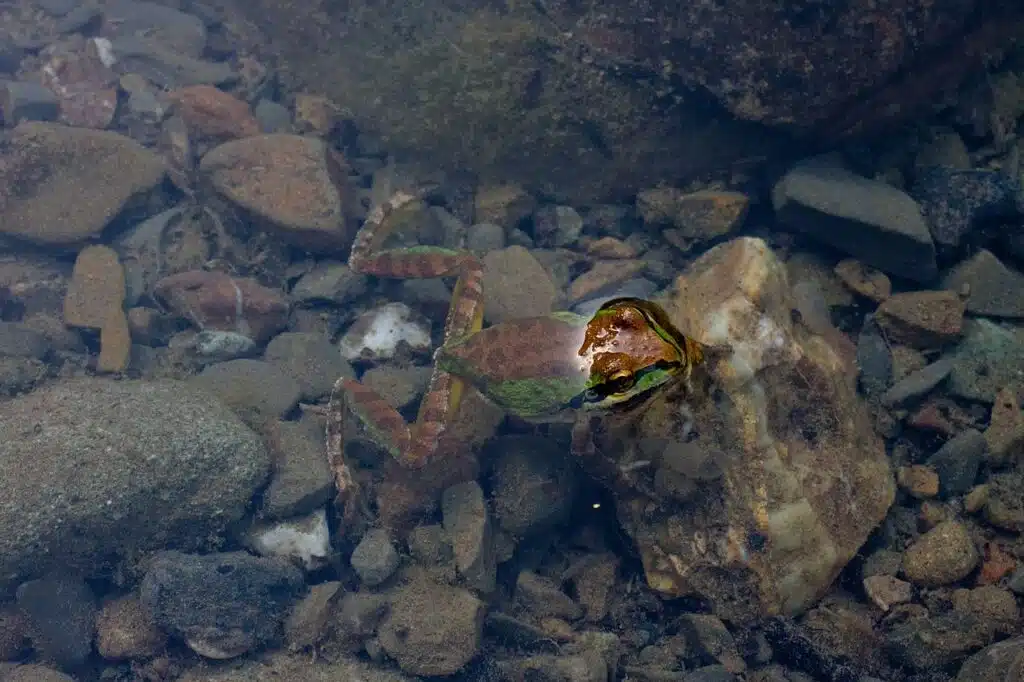
The Sierran Tree Frog (Pseudacris sierra) is one of the frequent frogs in California that changes colors.
It comes in gray, green, and brown colors with various patterns. Green color with a central brown stripe is a common sight for the frog.
Color changing happens over varying periods. It can take hours or days for this frog to completely change colors.
It eventually adapts to the colors of its environment.
The species is spotted soon after wintertime when it comes out of hibernation. Its hibernation spots include locations around water as well as secluded hiding spots such as under or in rotted logs.
The call of the species resembles a repetitive ribbit, ribbit sound head as soon as the species is ready to mate.
2. Baja California Tree Frog
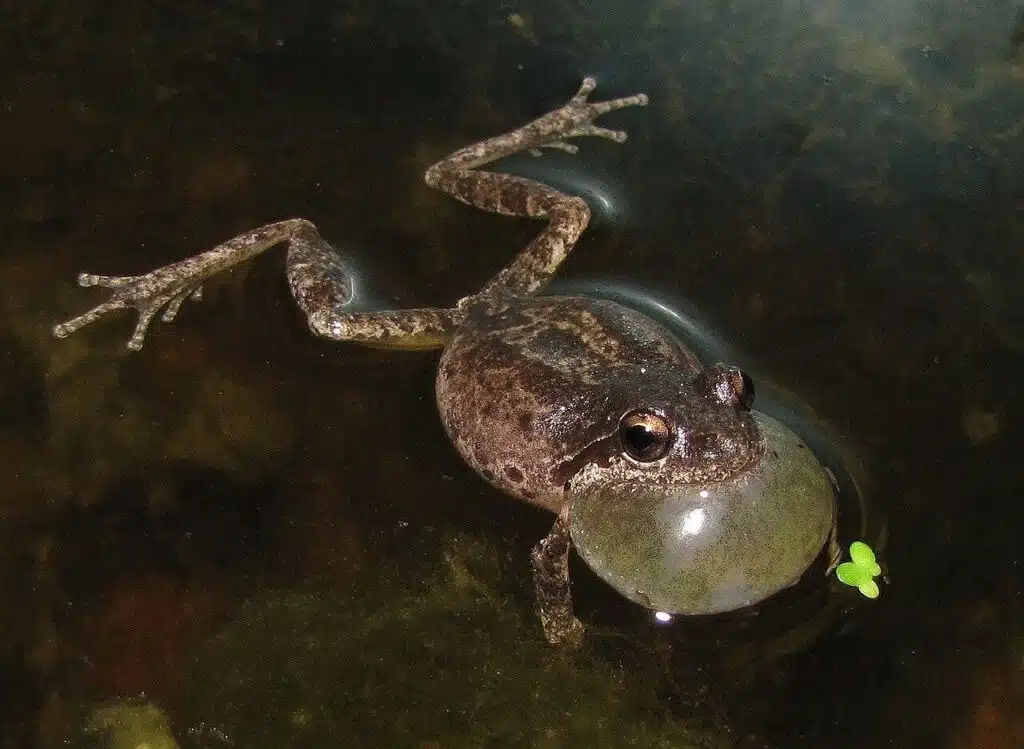
Baja California (Pseudacris hypochondriaca) is one of the most common species across the state. Like the Sierran Tree Frog, Baja California Tree Frogs can also change colors.
A period of a few hours to a few days might be needed for this species to completely change its appearance.
These types of frogs are among the species that can have a brown or gray color.
Widespread around the state and in Baja California, this frog has a widespread presence around Hollywood.
This has made the species a culturally-significant frog as its call has made it onto the big screen numerous times.
As with The Sierran Tree Frog, Baja California Tree Frogs are a species that have a clear ribbit, ribbit call that can change the tone.
3. American Bullfrog
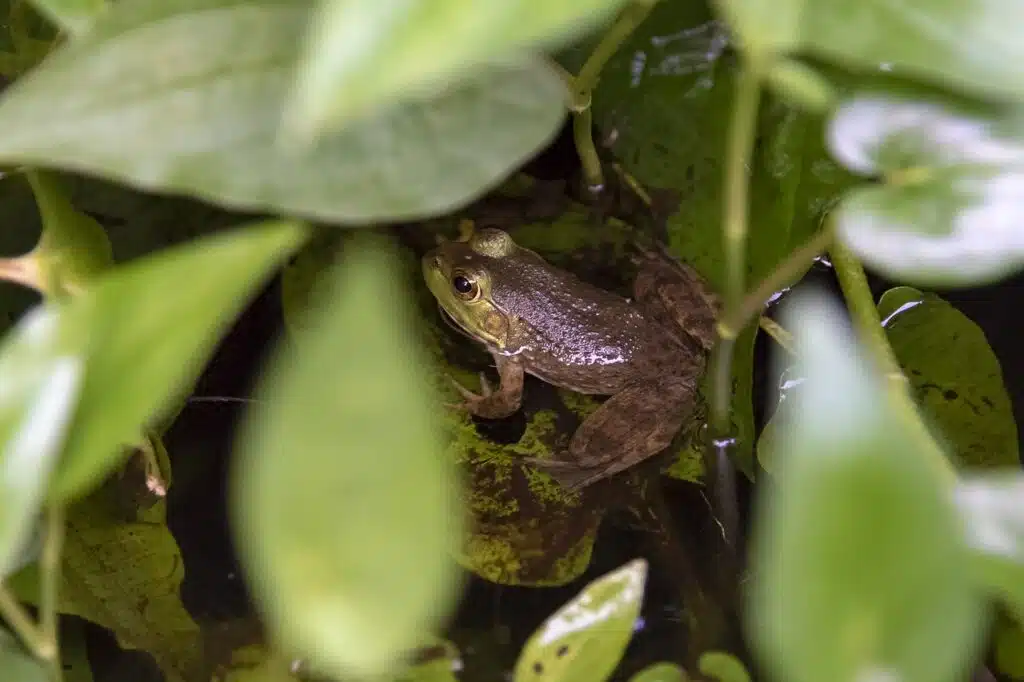
One of the largest frog species in the state is the American Bullfrog (Lithobates catesbeianus). This is one of the robust species with a dark body and a white ventral coloring.
The species is believed to be introduced both by accident and intentionally in California.
It has a distinct appearance and large size which allows it to have a loud call that resembles the belly sounds of a bull.
This frog has driven out many local species and has eaten other smaller frogs in California.
Multiple species are on the brink of extinction due to their aggressive nature next to permanent and temporary bodies of water.
The California Red-legged is one of the species impacted by the American Bullfrog.
4. California Tree Frog
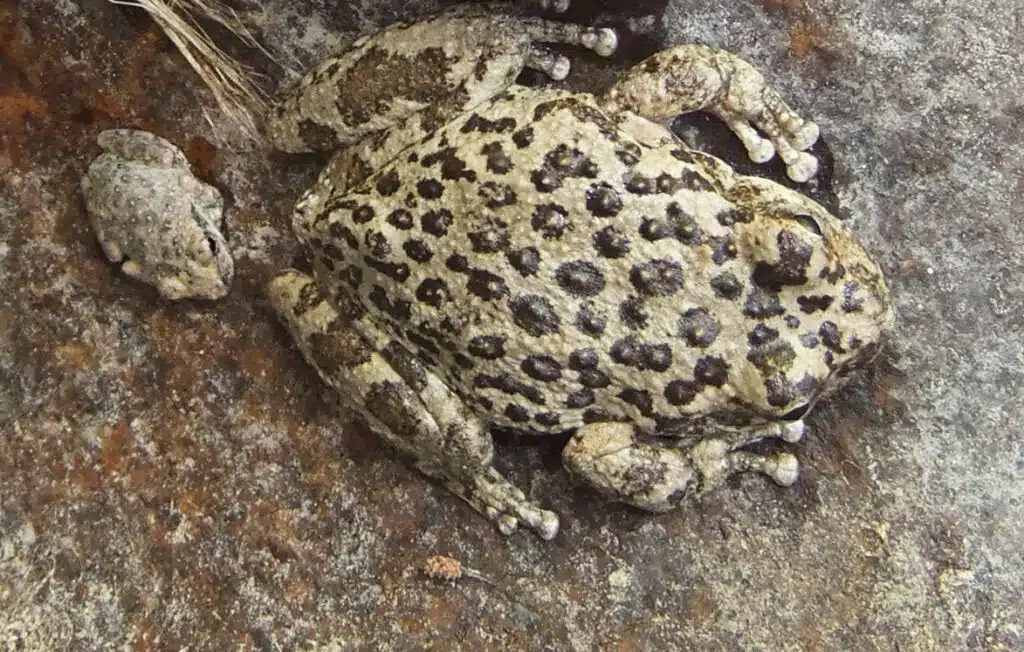
A very different call is heard from California Tree Frogs (Pseudacris cadaverina). A quack, quack call that resembles duck sounds is attributed to the species.
California Tree Frogs are some of the most colorful species in the state. They can be gray, green, and many other colors and color combinations.
These frogs are mostly found along California’s canals and are not a common occurrence around other types of water sources.
Southern parts of California are the only areas this species is seen around in the state.
Highly aggressive behavior is seen among male California Tree Frogs, but only during the mating season.
5. Foothill Yellow-legged Frog
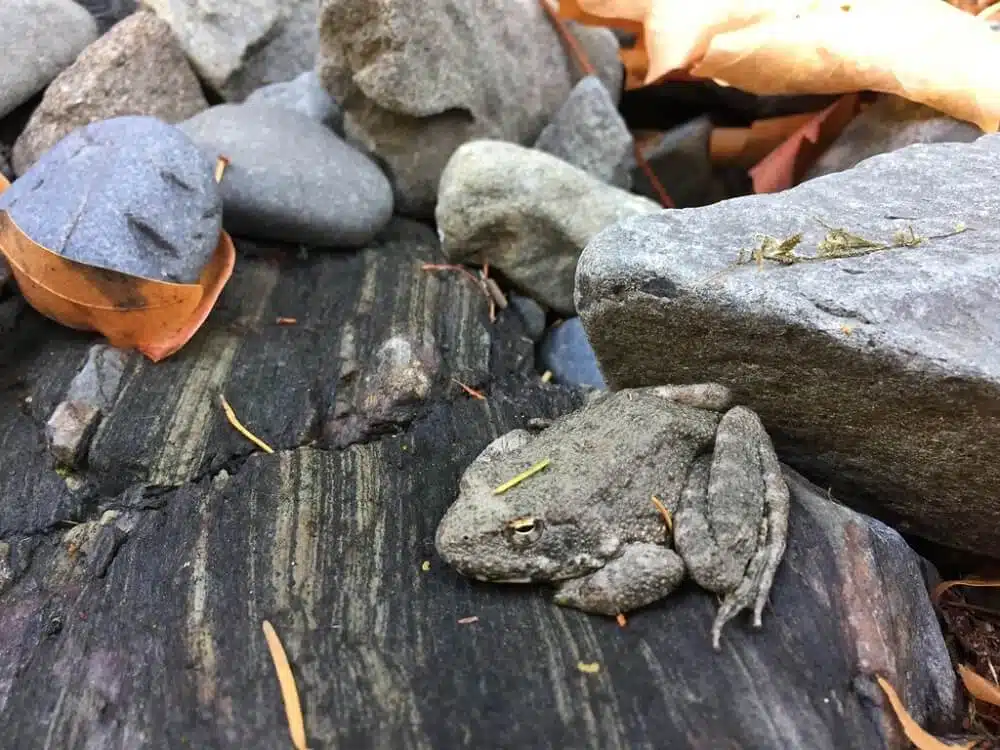
A distinct raspy call is characteristic of the Foothill Yellow-legged Frog (Rana boylii).
This is a species that has a low-pitched slow call that can be heard hundreds of yards away. Males call from water.
Various bodies of water including upmountain streams at elevations of up to a few thousand feet are the habitats of the species.
Foothill Yellow-legged Frogs are found all around California but in Southern parts of the state in higher numbers.
The species has green or gray color with or without red dorsal overlays. Its skin can be smooth or warty.
This species has also been known for its chemical skin secretions which stop certain infections from developing on its body.
Many water predators are known to eat this frog. This includes large waterbugs which eat its eggs and snakes such as garter snakes.
6. California Red-legged Frog
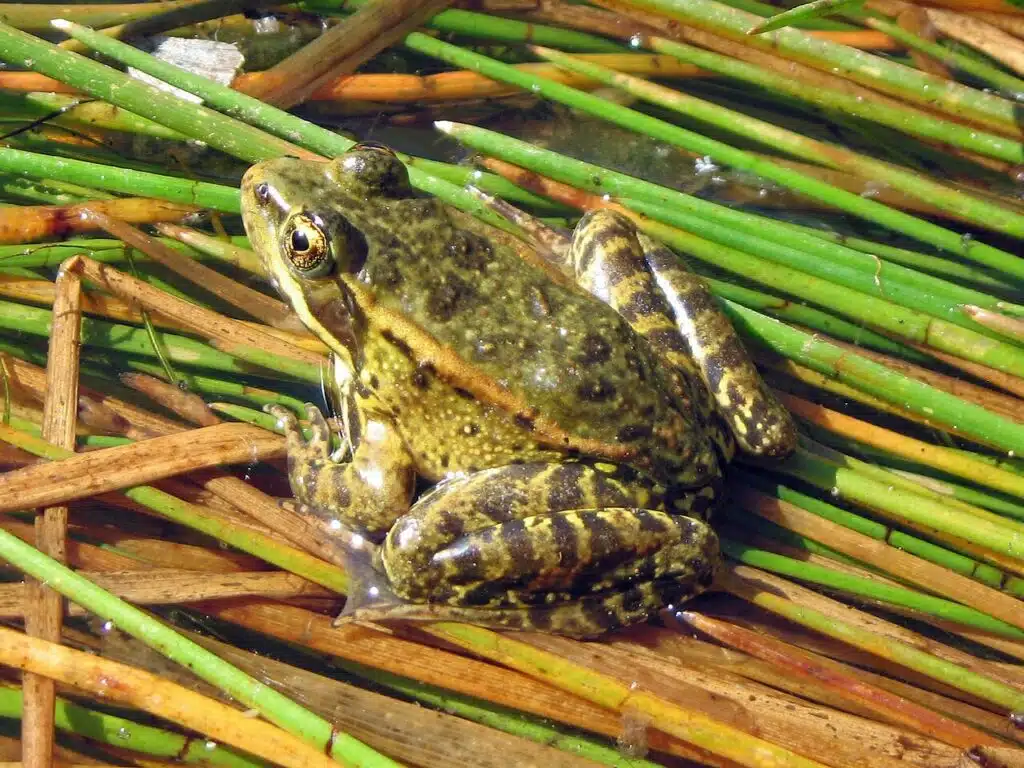
One of the vulnerable species of the state is the California Red-legged Frog (Rana draytonii). This is a species known for its lower populations across all of its habitats.
Efforts of raising its populations include a successful adaptation to the Santa Monica region as the species has been introduced to streams here.
This species has a gray, olive, or red-brown color as it’s known for its grunt, grunt calls.
California Red-legged Frogs are an important link to the ecosystem as these types of frogs are also food for other endangered species in the area such as newts and The San Francisco Garter Snake.
All of the areas it shares with The American Bullfrog, and introduced species in the state, are areas this frog can disappear from.
The California Red-legged Frog is the state’s official amphibian but its status remains uncertain with some positive results with introduced frogs in other new habitats of the state.
7. Northern Pacific Tree Frog
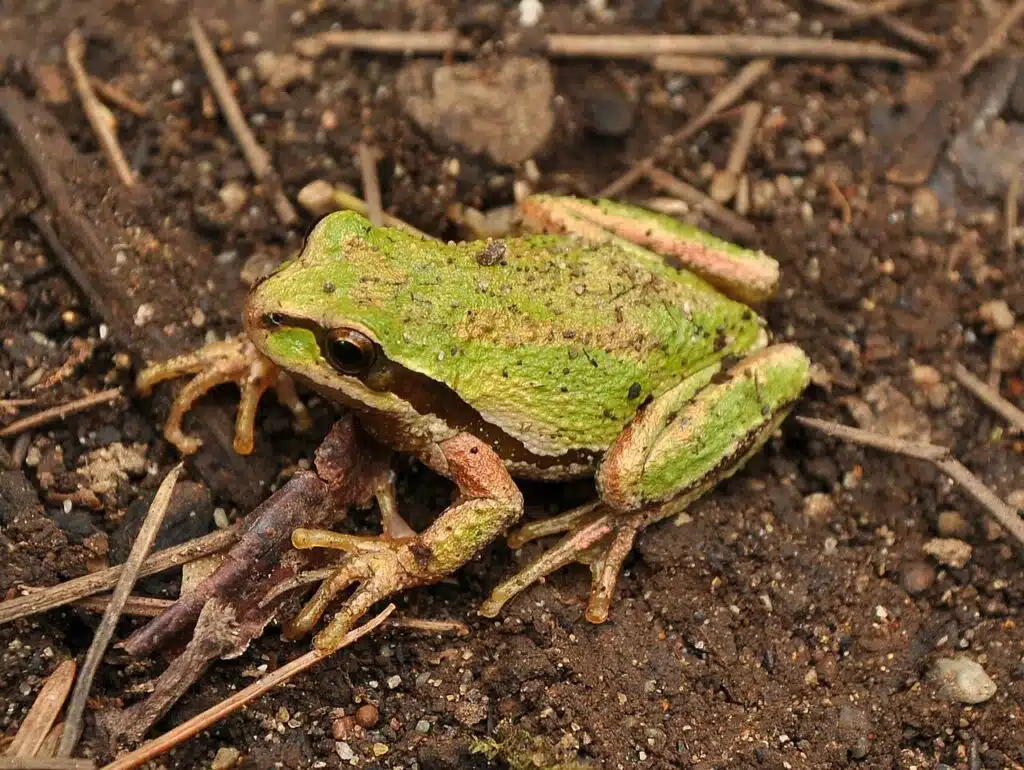
Southeastern parts of the state are also home to the Northern Pacific Tree Frog (Pseudacris regilla).
This species also comes in many colors, including a rare cream dorsal color.
Green and brown dorsal colors are more frequent, on the other hand. These colors can be handy in thermoregulation.
Green is better for extra warmth in cold climates as the color absorbs energy from the sun while brown is superior in hotter areas of the state.
This is a species known for its high levels of aggression during the mating season. Male Northern Pacific Tree Frogs compete for females by call tonality and loudness.
A 2-part call has been described for the species. This is a rib-it, rib-it type of call.
8. Northern Red-legged Frog
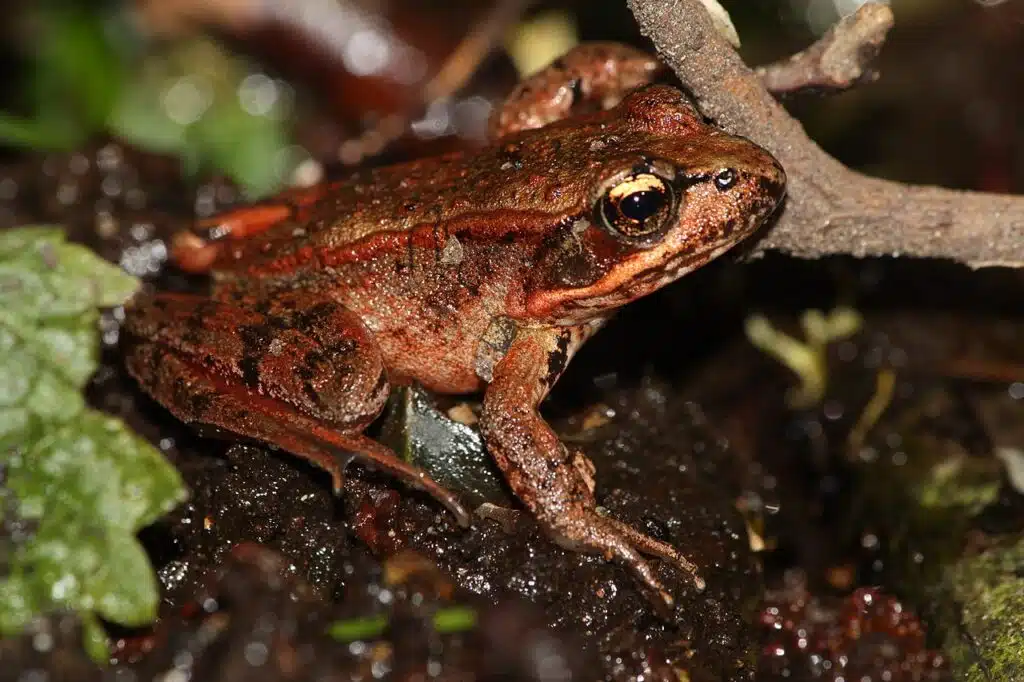
This type of frog is one of the 2 species in California generally known as Red-legged Frogs (Rana aurora).
They inhabit Northern territories compared to The California Red-legged frog.
Different coloring has been associated with this species which is rarely red.
A black, brown, and red color morph is frequent for these frogs. Red overlays make the species appear poisonous.
The mostly brown color of these frogs is also common. This morph features bright green dorsal spots as well.
Much of the coloring of this species is impacted by its environment.
The call of this Northern frog is also different from the call of The California Red-legged frog.
A long call made from up to 7 uuh sounds makes the call of this species unique.
9. Sierra Nevada Yellow-legged Frog
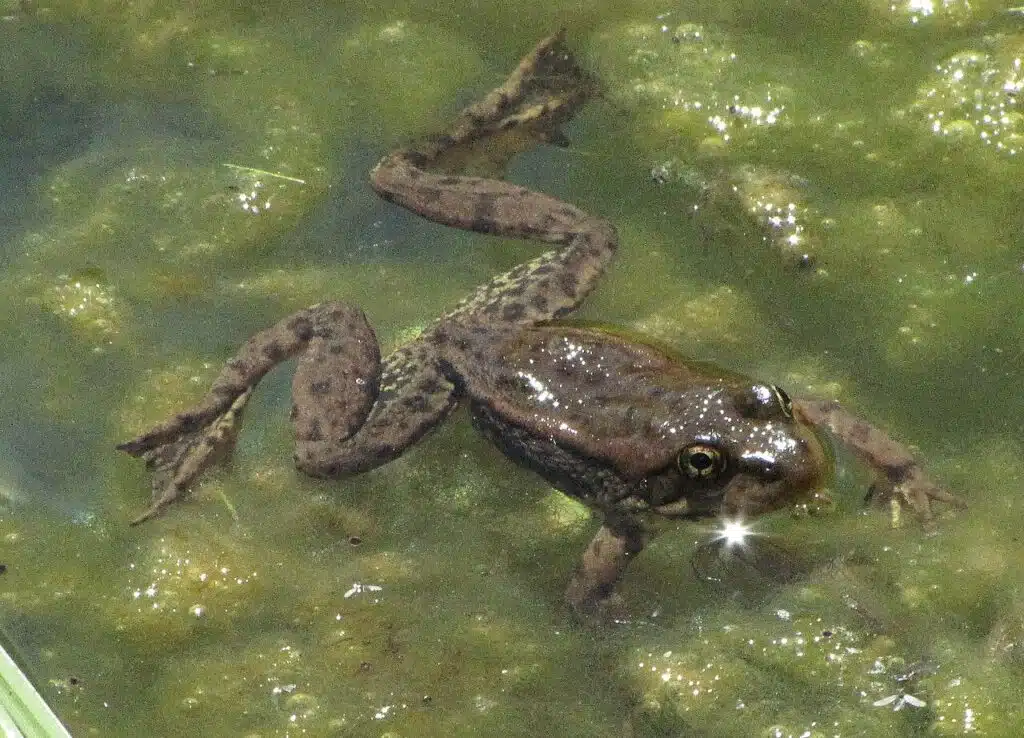
Sierra Nevada Yellow-legged Frog (Rana sierrae) still lives West and East of Sierra Nevada and around Lake Tahoe.
This species has been listed as endangered a few years back and it’s believed to have almost all of its population in the state extinct.
Green color with dark green or black splotches is specific to this species.
These dorsal markings resemble algae and they serve as camouflage even if these frogs may be found in areas with rocky terrains and rare vegetation.
The species has short waak waak calls which get high-pitched towards the end of the call.
Some efforts to save this species are in place. For example, Sierra Nevada Yellow-legged Frogs have already been introduced in areas such as lakes without fish.
Some frogs have also been introduced to lakes with fish, but only with native fish.
10. African Clawed Frog
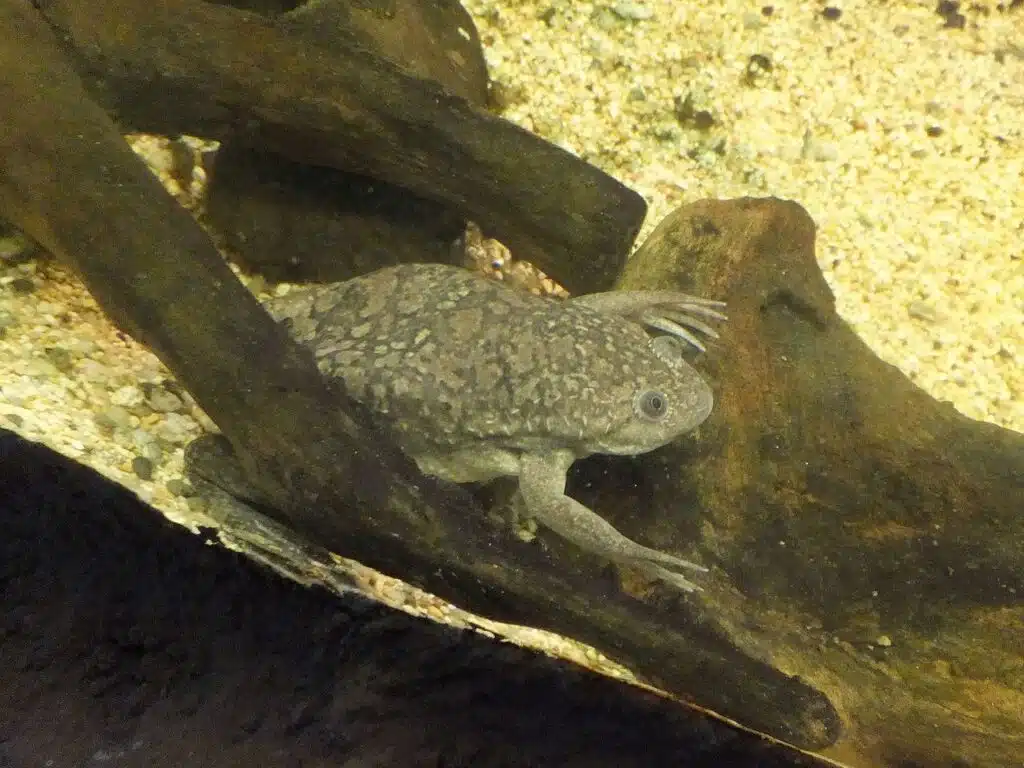
This type of frog (Xenopus laevis) has an introduced status in the state and it can be one of the most resilient species in California.
High adaptability is an attribute of this species, as is cannibalism. Adults can eat the tadpoles of their own species in areas where there’s no other food.
Some continue doing this even when there’s other food in their habitat.
These types of frogs are true carnivores and scavengers. They eat living bugs and worms but can also eat dead prey such as decaying fish.
Much of the time is spent underwater or on the ground as these frogs only have their heads sticking out.
They come out only to feed and mate.
Male African Clawed Frogs are known to mate with the females of other species as well.
The call of this species is a tri-ill, tri-ill 2-part call with a short duration and high repetition rate.
11. Cascades Frog
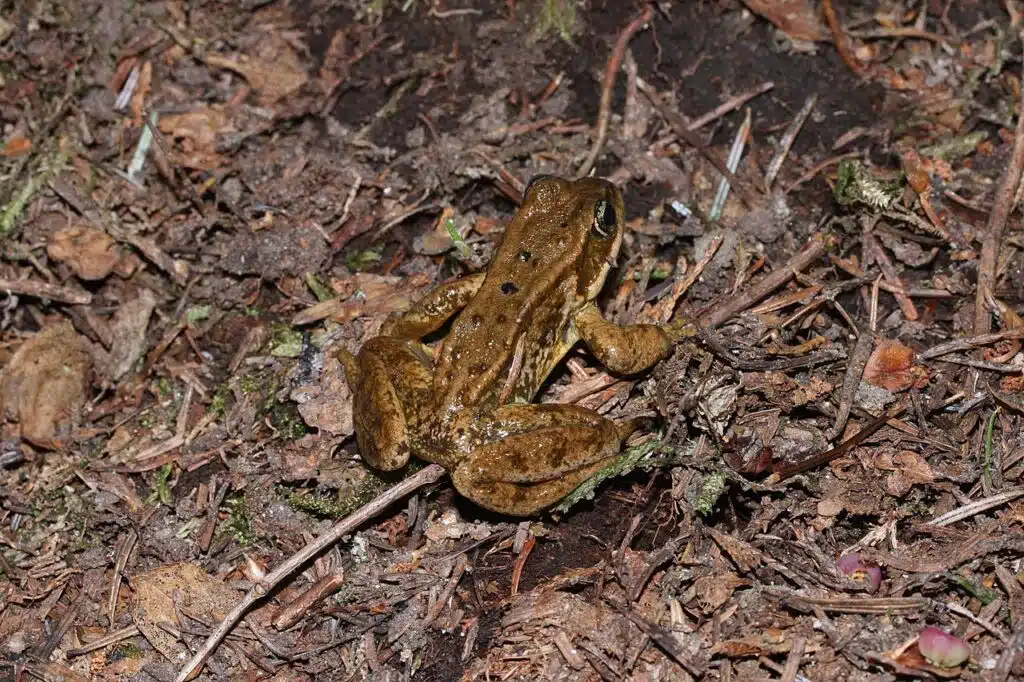
Lakes and marshes are the freshwater habitat preferences of Cascades Frogs (Rana cascadae).
This is a type of specific frog found around The Cascade Mountains and Northwards along The West Coast.
Distinct black dorsal patterns on this species make it look completely different from other frogs.
The coloring of the species is influenced by its habitat which concentrates around the volcanic area on the peaks of The Cascade Mountains.
These frogs are highly active at night when they come out for food.
Calling and mating also take place at night.
The call of the species is low-pitched. It resembles low-pitched clicking sounds.
Snakes and raccoons are among the common Cascades Frogs predators.
12. Coastal Tailed Frog
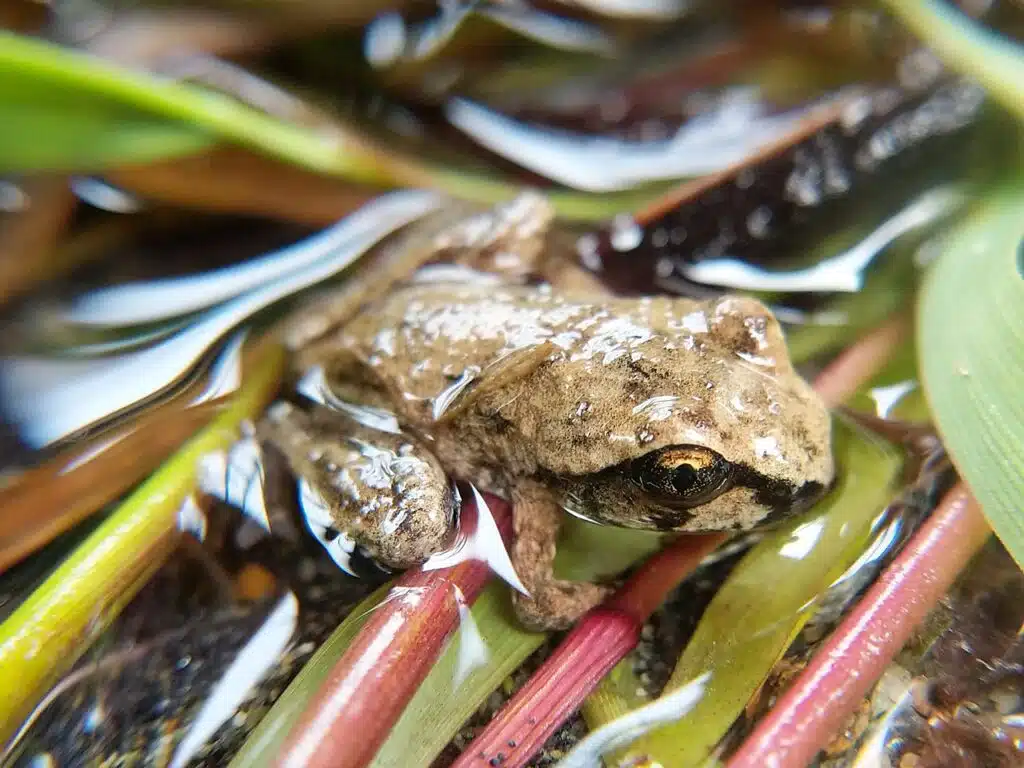
Coastal Tailed Frogs (Ascaphus truei) are some of North America’s more distinct species.
Male Coastal Tailed Frogs have tails which are reproductive organs. This allows for internal female fertilization.
This means the eggs of the female are safer than being exposed to predators or sweeping water currents.
Found in different colors including dark black and green, the Coastal Tailed Frog is one of the longest-living frogs in the state and the world.
It can live up to 20 years but it also requires at least 8 years to reach sexual maturity and to be ready to mate.
The challenge of the species’ survival is to live long enough to reach its mating age before falling prey to its multiple predators.
13. Southern Mountain Yellow-legged Frog
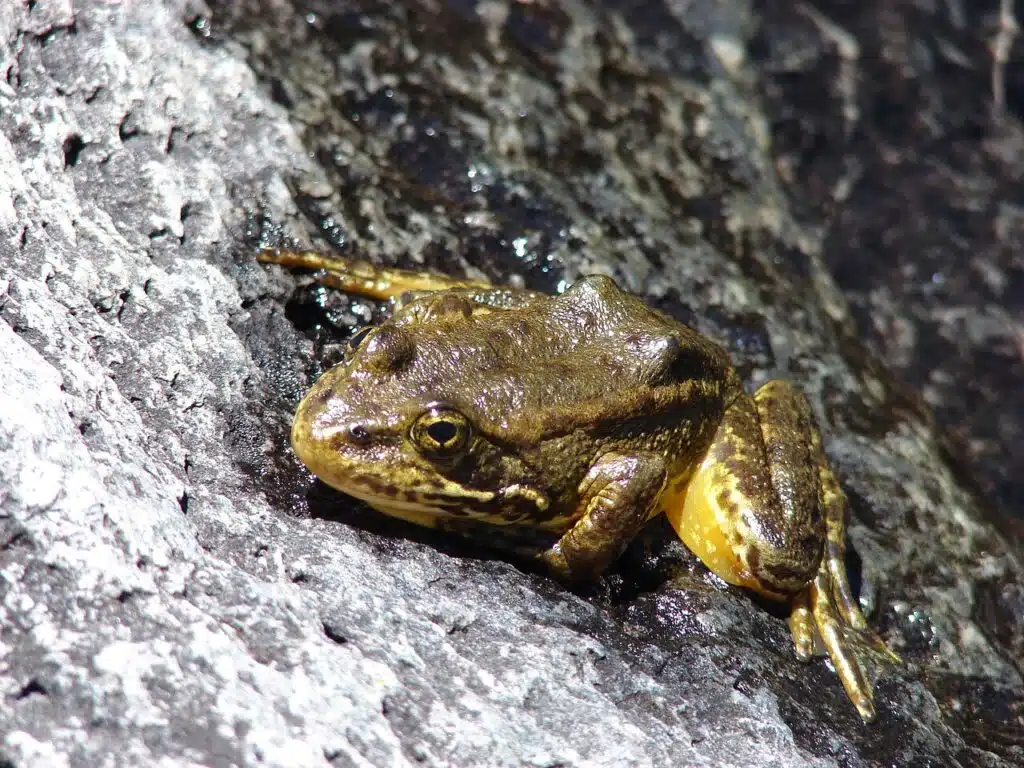
Olive coloring with black dorsal patterns is specific to the Southern Mountain Yellow-legged frog (Rana muscosa).
This is another species with an endangered status in California.
Still living in Southern parts of the state, this species is only confirmed in a handful of sites from its known sites which used to number more than 100 locations years ago.
The species faces pesticides in its habitat and industrialization which further diminishes its habitat.
It has been bred in captivity to save the species. As a result, the Southern Mountain Yellow-legged Frog can be seen at the San Diego Zoo.
This species has a wa-aak, wa-aak 2-part call which is low-pitched in the first part.
14. Rio Grande Leopard Frog
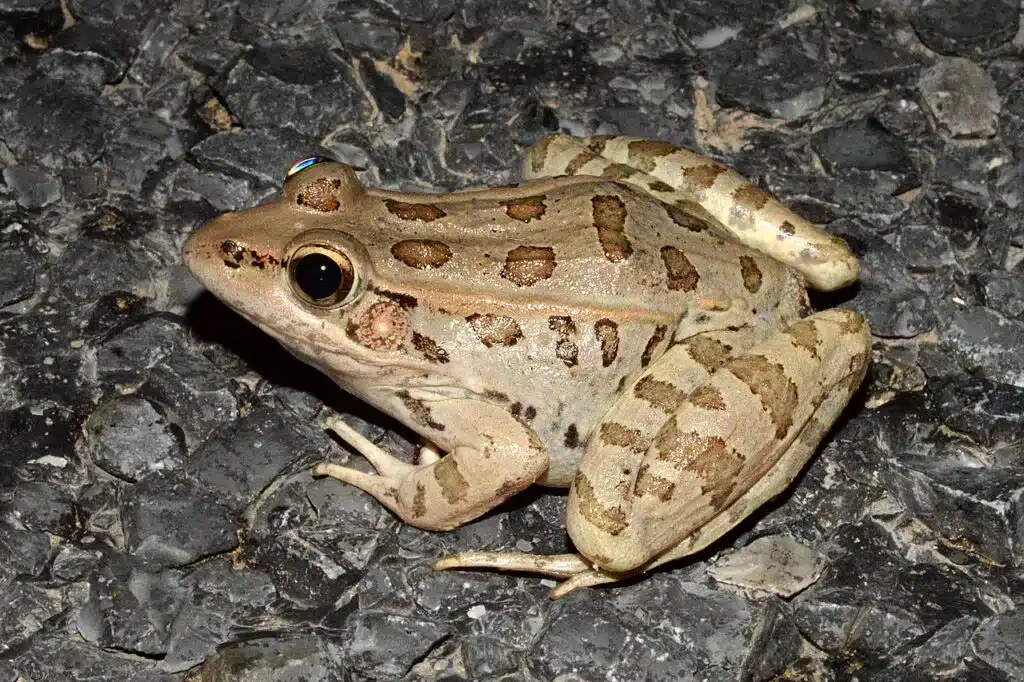
Named after the leopard-like patterns on its dorsal side, the Rio Grande Leopard Frog (Lithobates berlandieri) was believed to be a morph of the Northern Leopard Frog in the past.
This species is native to Mexico and it has been introduced to Southern and Southwestern US states, especially along The Colorado River.
The species has adapted and it now has an expansive range in the Southern parts of California and Baja California.
It enters conflicts with local frog populations such as with the endangered Lowland Leopard Frog.
The call of the species is very loud compared to other calls. This is a rattling noise that can be heard from a long distance.
15. Common Coqui
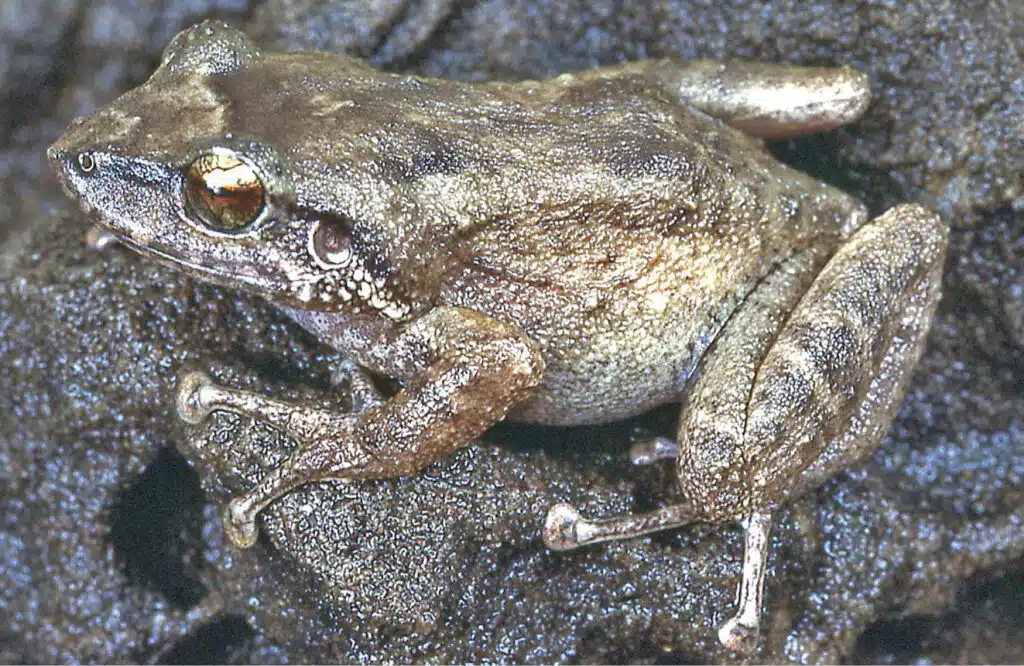
Common Coqui frogs (Eleutherodactylus coqui) are identified by their earth-brown nuances. These frogs have an average size compared to others in the state.
The name of the species is further inspired by the sound of its call. A co-kee, co-kee, co-kee, highly repetitive and highly-pitched.
The dual nature of this call is believed to be split by purpose. The first part of the call is aimed to repel other males while the second part is aimed to attract females.
Frogs of this species are believed to live up to 6-7 years but most fall ill, die, or fall prey to predators within the first year of their life.
Arthropods are the main food of the adult Common Coqui while juveniles eat ants and other small insects.
16. Southern Leopard Frog
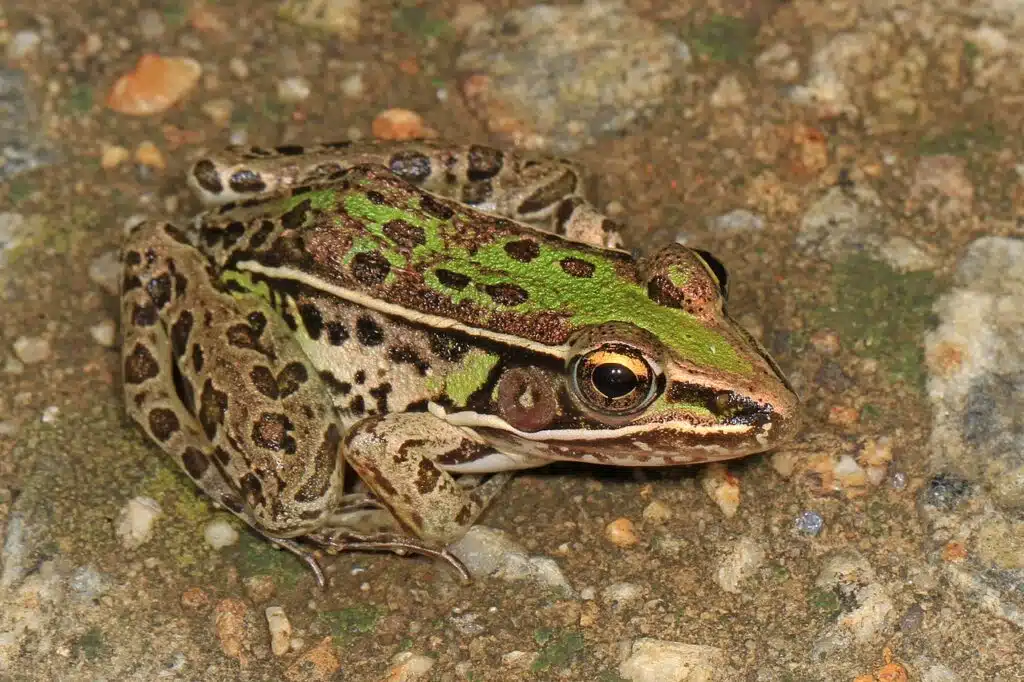
Some of the most common leopard frogs in North America are Southern Leopard Frogs (Lithobates sphenocephalus).
This species is found in high numbers across multiple states but it has an introduced status in California.
A confirmed introduced status of the Southern Leopard Frog in California is tied to the Prado Reservoir.
Southern Leopard Frogs are also found along the San Joaquin River.
This species is found around freshwater sources as soon as wintertime is finished. Warmer temperatures prompt the species to come out of overwintering spots.
These are typically unfrozen bodies of water.
Calls of the Southern Leopard Frog resemble triil, triiil, low-pitched noises.
17. Northern Leopard Frog
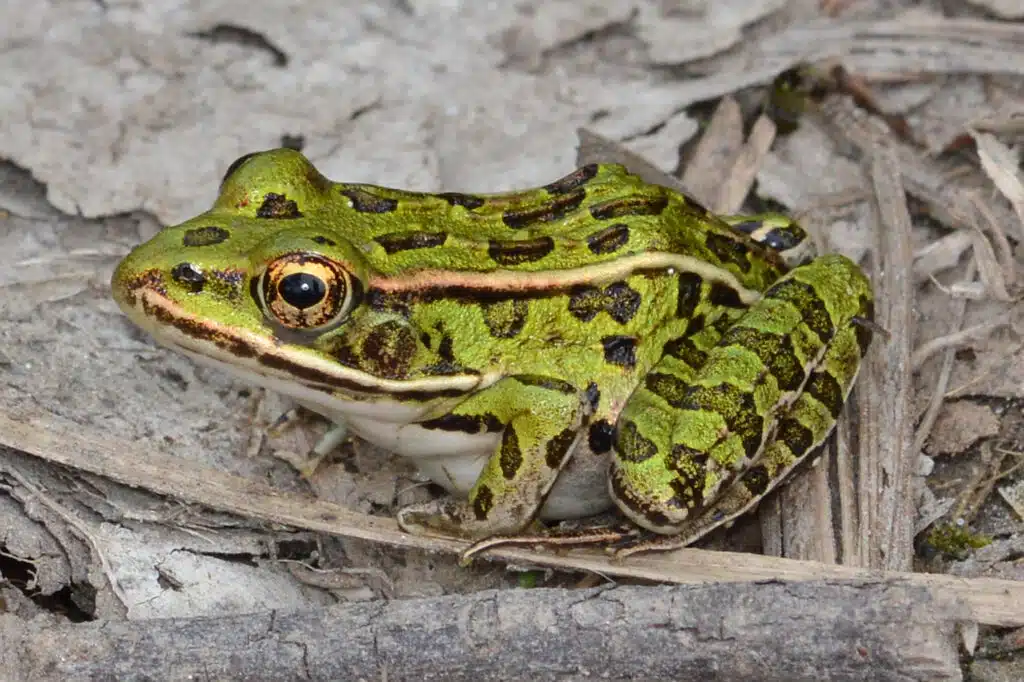
This colorful contrasting Northern Leopard Frog (Lithobates pipiens) has a base green, brown, or black color with black blotches.
Some morphs of the species show dark brown spots and white lateral stripes across the lateral dorsum.
It has widespread North American distribution but it only lives in small populations in California.
A popular species for medical research, this species also has a distinct call.
Its call is an initial grunt with multiple following grunts.
18. Lowland Leopard Frog
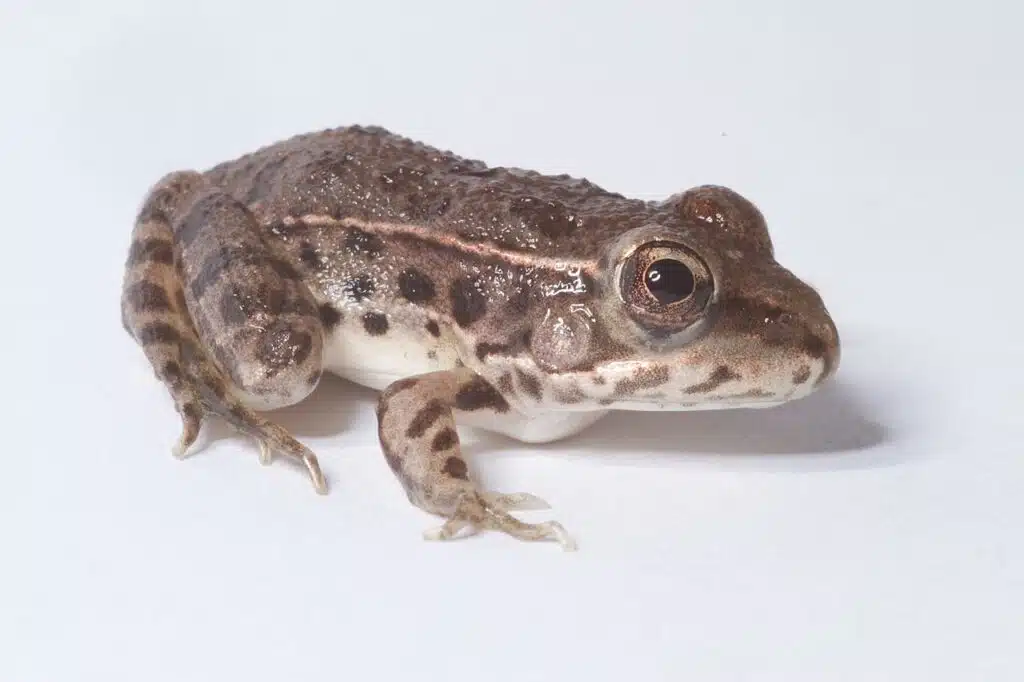
One of the rare species of frogs found both around permanent and temporary bodies of water is the Lowland Leopard Frog (Lithobates yavapaiensis).
This species has an endangered status across multiple habitats, especially in areas with larger frogs.
The American Bullfrog is one of the species that feed on the Lowland Leopard Frog eliminating it from its habitat.
Calls of this species are low-pitched snore-like sounds.
Freshwater lakes and ponds in California and Mexico are home to the species.
19. Boreal Toad
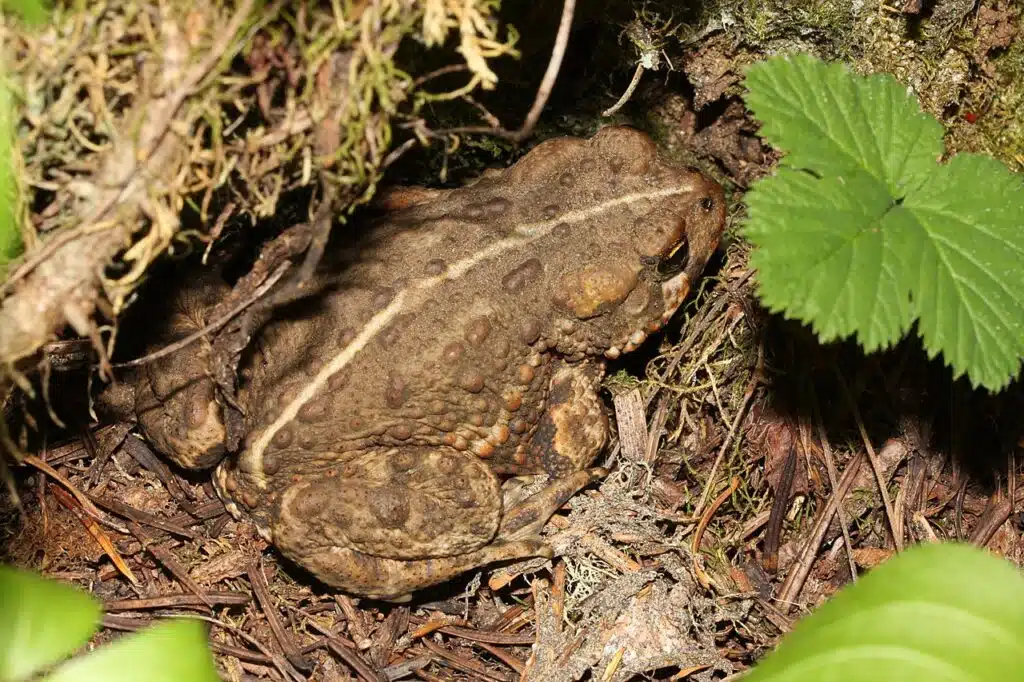
Boreal Toads (Anaxyrus boreas boreas) are some of the most common species of toads in California. These are the toads known to reach a size of up to 4 inches.
The large specimen has no vocal sac which means Boreal Toads have no mating call.
Coloring and blotches on the back of the species are known to be seen both on its dorsal and on its ventral sides, which makes for easier distinction from other similar California toads.
These toads are sometimes seen eating bugs and insects. Grasshoppers are among the most common prey of the species together with different types of beetles.
20. California Toad
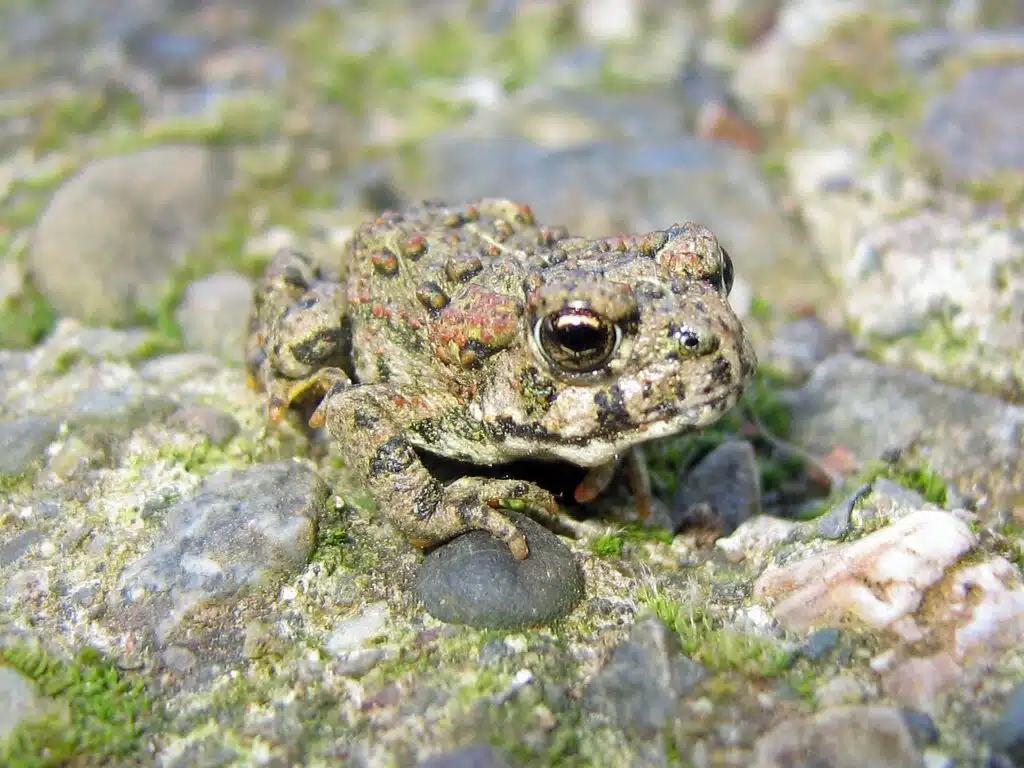
One of the most common toads of the state is the native California toad (Anaxyrus boreas halophilus) which lives in almost all habitats except Southeastern California.
This species is a small type of toad. Various shades of green are specific to its dorsal side.
Brown spots are seen on its body as well.
If the toad has warts, these brown spots are located on them.
California Toads are mostly insectivores preferring flies, bugs, and other insects as prey due to the reduced size of the species.
Grasshoppers are among their preferred bugs. The high number s of mosquitoes in their humid habitats also makes them ideal prey for the California toad.
The call of the species can be heard from January to July, the mating season of the toad.
A high-pitched call is specific to the species.
21. Yosemite Toad
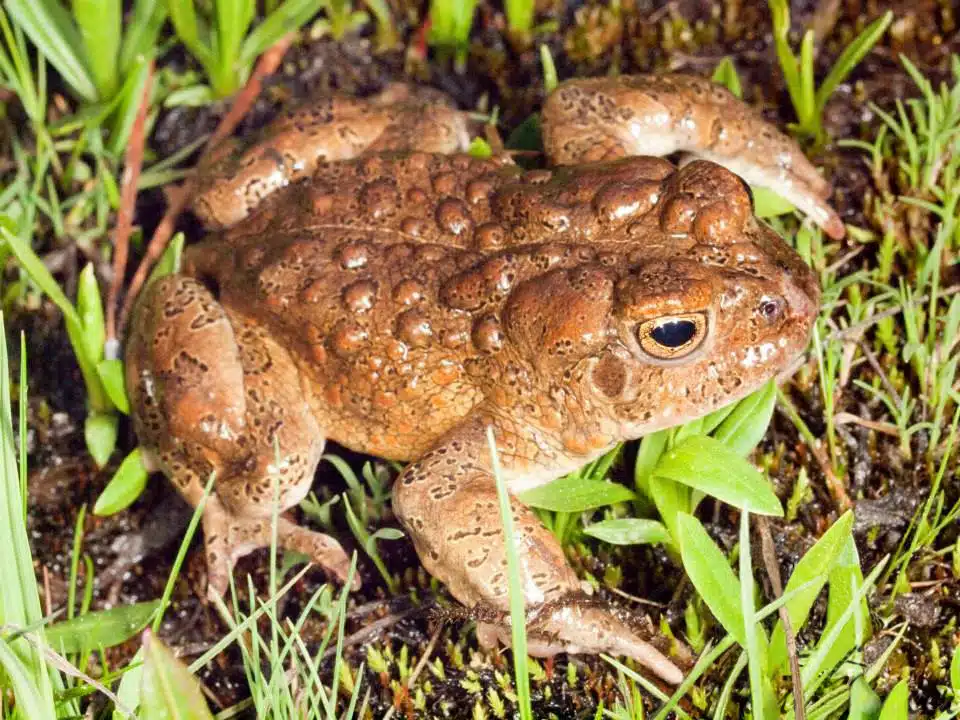
Southeastern California habitats are home to the Yosemite Toad (Anaxyrus canorus).
Green to brown or brown toads is some of the most common morphs of this species. Large warts are specific to this species.
A light green base color is specific to this species with light brown patches on its warts and its head.
Named after its habitat in the Yosemites, this is a species adapted to living at high elevations. It uses small temporary water accumulation spots on mountains to live and breed.
The diet of the species is mainly based on bugs and insects. Mosquitoes are among the frequent prey options for Yosemite Toads, alongside caterpillars and various types of ants.
Both males and females are adapted to living in cooler weather at high elevations and the species lives a long life surviving up to 15 years.
It takes at least 3 years for this species to reach sexual maturity to mate, which is also a limiting factor when it comes to growing its population.
Male Yosemite Toads are known for having one of the most distinctive calls in California and North America.
This is a species that sounds like a flute when calling. Its long triiil sound has been compared to the sound of a classic flute.
22. Red-spotted Toad
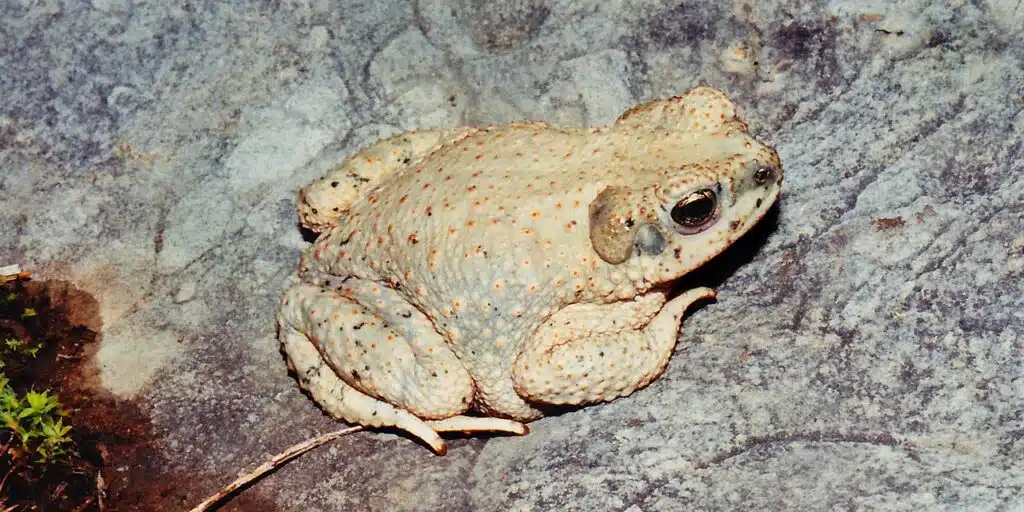
Red-spotted Toads (Anaxyrus punctatus) may sometimes be spotted after it rains in Southern parts of California and Baja California.
This is a species named after one of its morphs which shows pink to red spots.
A green morph of the species also exists. It has larger black spots and tiny red spots on its dorsum and legs as well.
The toad is a common sight along rivers and streams, particularly around temporary water accumulation around streams.
Rocky terrains along rivers are home to the gray morph with red spots.
This species grows to a maximum size of 3 inches and it has a high-pitched trill call.
23. Woodhouse’s Toad
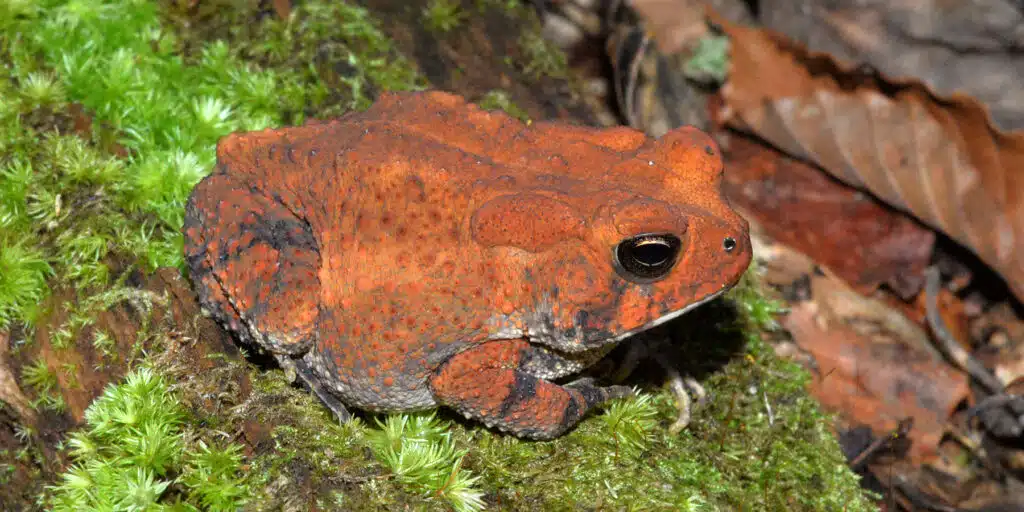
Gray and brown morphs are the most common for these toads (Anaxyrus woodhousii).
Woodhouse’s Toads are some of the largest species in the state with the largest individuals measuring up to 5 inches.
A stable population is noted for this species but sightings are rare since the toad is nocturnal.
Woodhouse’s Toads are among the species heard in ditches around streams and rivers. It seeks out temporary bodies of water in its habitat to lay eggs in.
These bodies of water are typically within a mile of a stream or a river.
Also known for a long breeding season, Woodhouse’s Toads might even be growing in numbers as it has just a few natural predators.
A large species but an insectivore, this toad also has a low-pitched snore-like call.
24. Arroyo Toad
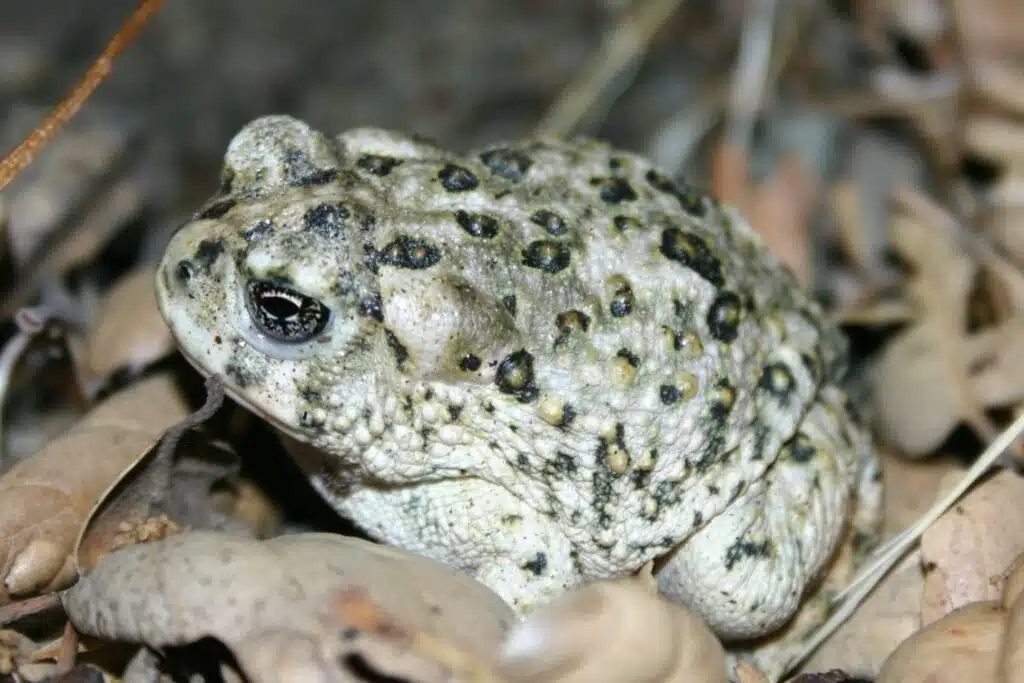
One of the small to medium-sized toads of the state is the Arroyo Toad (Anaxyrus californicus). This is a species that has a white or gray color as a juvenile which darkens as the species matures.
A hopping species, the Arroyo Toad is found next to ponds and rivers.
Sandy terrains and rocky terrains are among its favorites.
This species is nocturnal and only sticks its head out of the soil during the day except in its mating season.
A tendency to decrease numbers is noted for this species. This is a toad impacted by other species in its habitat such as snakes.
Garter Snakes eat these toads together with invasive species of frogs such as The American Bullfrog.
This species has a long call that lasts seconds and which resembles a triiiil, triiil sound with a rising pitch.
25. Arizona Toad
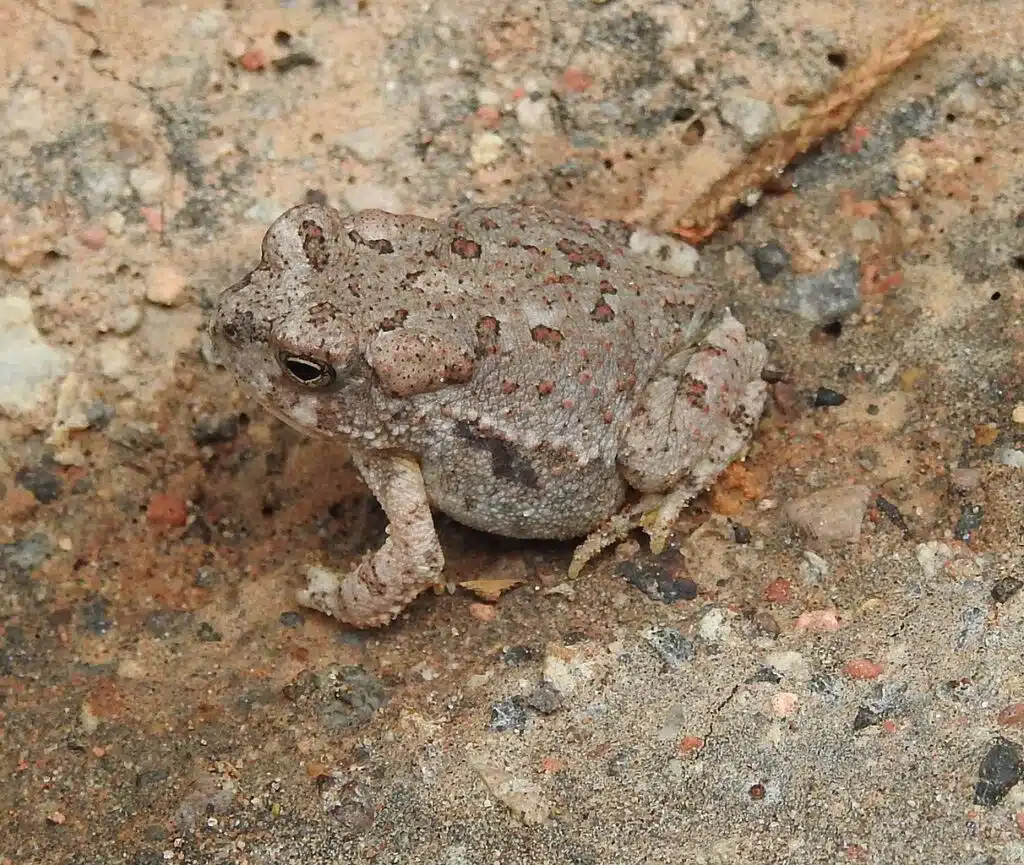
One of the common species of the Southeast is the Arizona Toad (Anaxyrus microscaphus). The species faces diminishing numbers but it’s not yet listed under an endangered status in the state as in other Southern states.
While an adaptable species, this toad faces a diminishing habitat at lower elevations due to urbanization.
It can survive at higher altitudes, but not higher than 6.000 feet.
Arizona Toads have variable coloring. The species has earthy nuances.
A mud-gray morph is widespread. This morph also shows brown dorsal patches and small skin warts.
The mating season of the Arizona Toad is a period when the species can be spotted.
Male Arizona Toads are among the species that may mate with the females of other species. They might favor female Woodhouse’s Toads.
Males are heard with their long calls that last up to 6 seconds. A triiiil, triiiil call with a rising pitch towards the end is specific to these males.
26. Sonoran Desert Toad
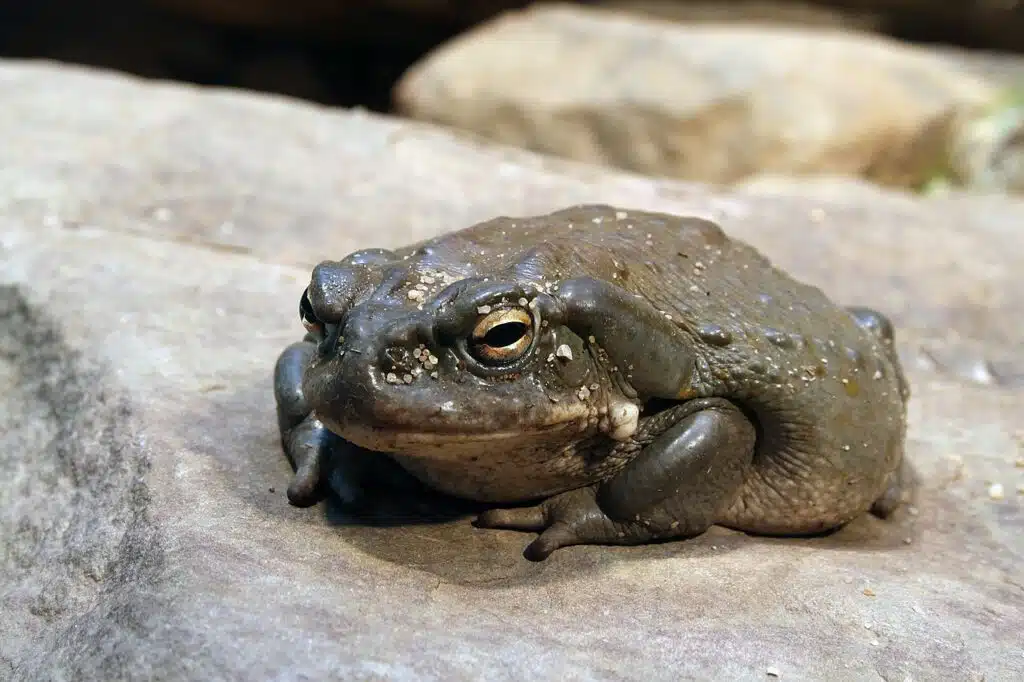
This dark toad (Incilius alvarius) has different names such as The Colorado River Toad.
A dark green or a dark olive color is specific to this toad which has a cream to white ventral coloring.
Small brown dorsal spots are also seen on the adult Sonoran Desert Toad.
Snoran Desert Toads are some of the largest in California. This is a species that reaches a maximum size of over 7 inches.
Only found in the Southeastern parts of California, Sonoran Desert Toads are also some of the poisonous species in the state.
A released vaporized chemical of the species might kill animals the size of a dog easily.
Some of the first symptoms of an intoxication following accidental chemical inhalation from this toad include hallucination.
The species is often illegally collected for collecting its poison which is then crystallized.
A low-pitched call is specific to this large toad. Screeching and whistling sounds are specific to its call.
27. Great Plains Toad
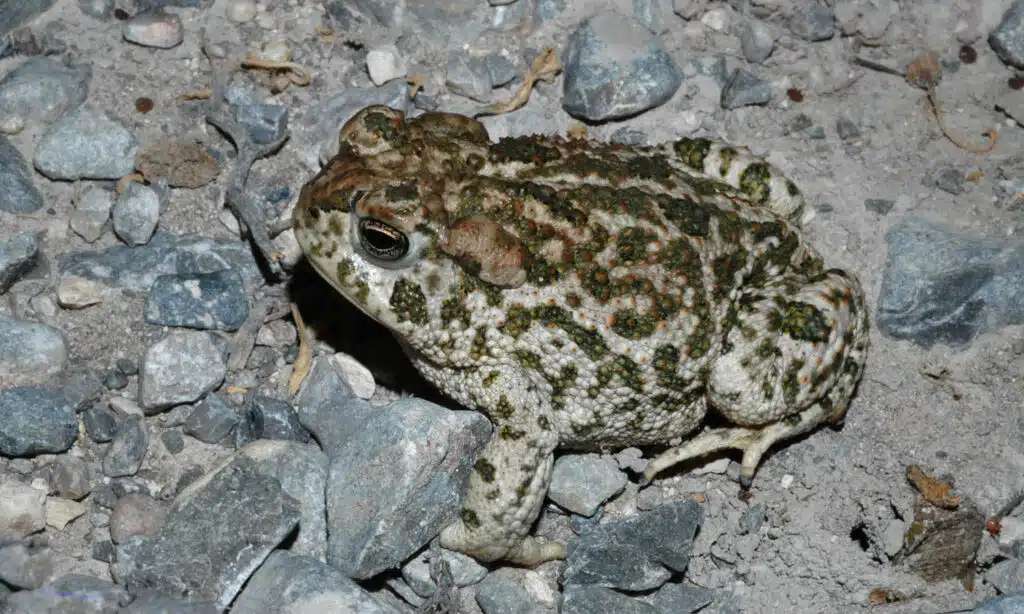
Great Plains Toads (Anaxyrus cognatus) are also one of the larger species across California.
This is a toad that can grow to a size of up to 4.5 inches and which takes on the coloring of its environment.
A common sight across moist areas of woodlands, this species often comes in different shades of brown.
Cutworms, ants, and termites are among their prey preferences.
Great Plains Toads living on grasslands are also seen as prey by other snake specie such as various garter snakes.
A loud chirping call is specific to the male Great Plains Toad.
28. Black Toad
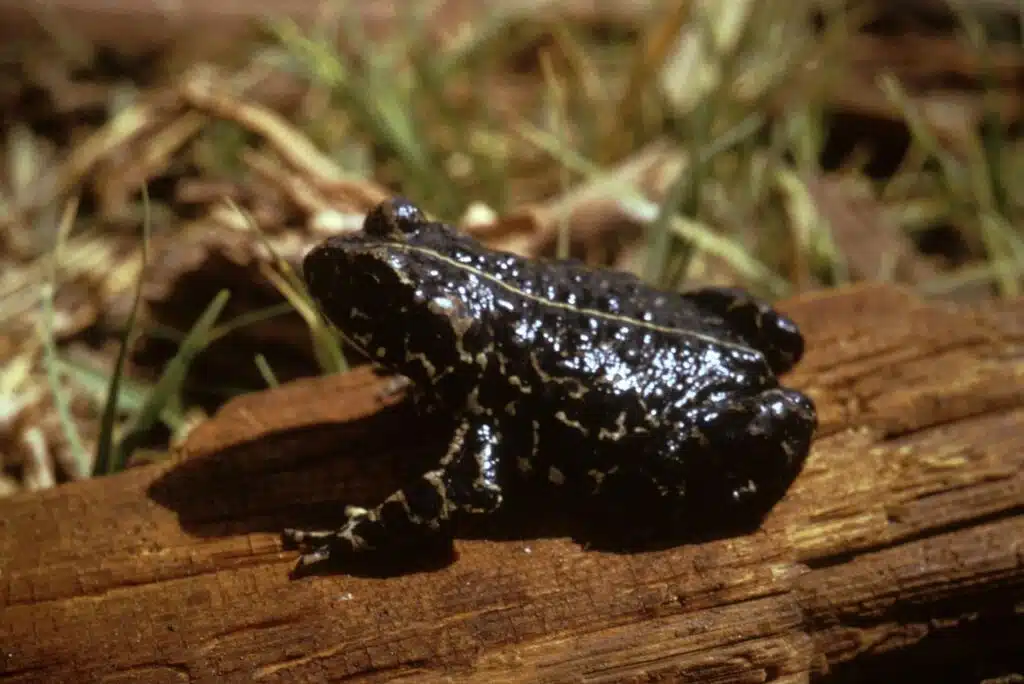
Black Toads (Anaxyrus exsul) are one of the rare mostly black species in the state. This toad also shows a tendency to be more aquatic than other toads.
A black base color with white or gray speckles helps identify this species.
No other morphs are known for this species which is found in shallow marshes during the mating season.
Breeding takes place once the male Black Toad starts to call. A high-pitched pinkling-like noise is specific to this call.
29. Western Spadefoot
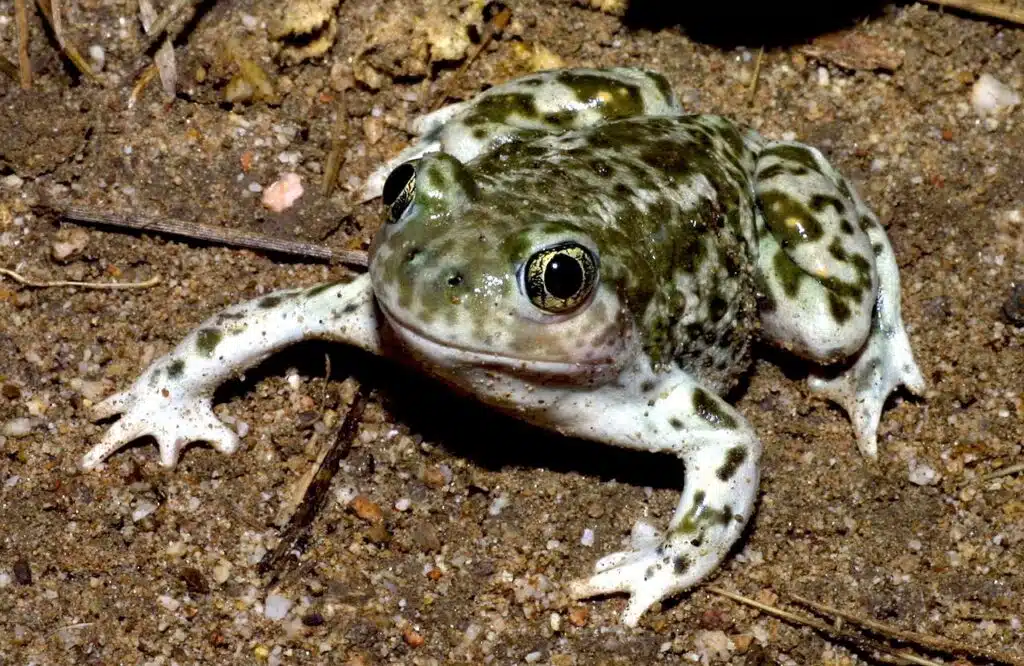
Western Spadefoot toads (Spea hammondii) are among the species that may appear white. However, they have a light gray color or a mid-gray nuance in most cases.
This species is known for its cannibalistic feeding behavior in its early stages. It moves onto insects as it matures.
Western Spadefoot Toads are some of the longest-living species in the state as they can survive more than a decade.
Short sharp trill sounds are specific to the call of the species.
30. Great Basin Spadefoot
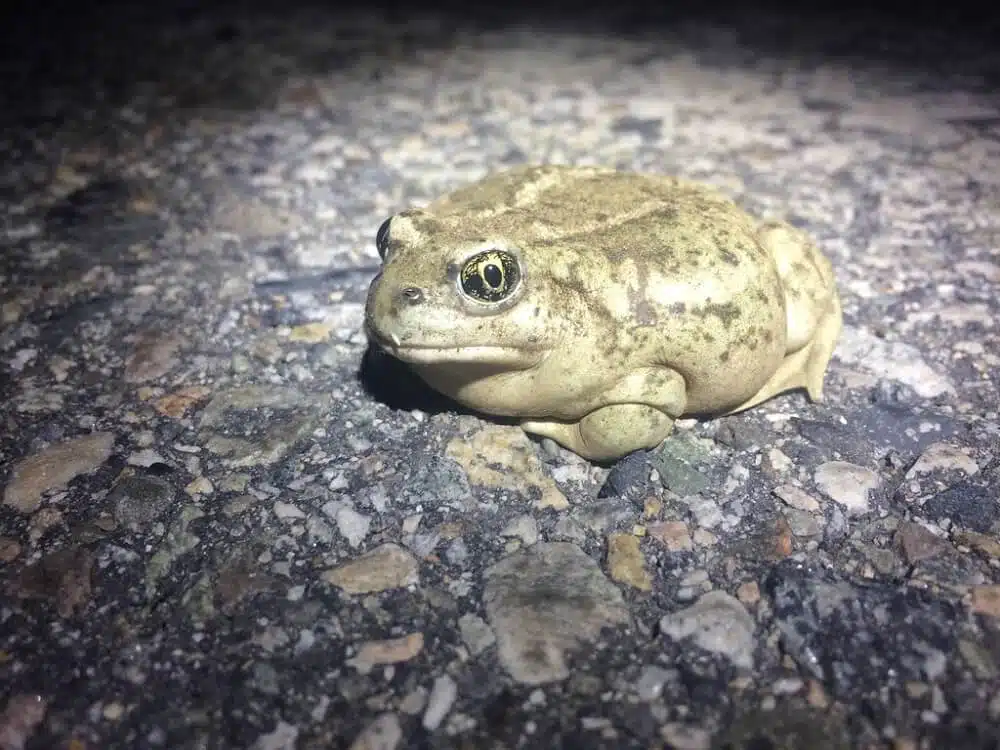
Great Basin Spadefoot toads (Spea intermontana) are found in small areas across California.
Beetles, ants, and true bugs are among the common prey of these toads.
The breeding season marks the period when the toad can be spotted in the state as males gather in large choruses to call for females.
The call of the species has 3 parts. All of these parts compose a duck-like snore sound which is very loud.
These toads retreat to the ground after mating where they spend most time hiding in moist soil.
31. Couch’s Spadefoot
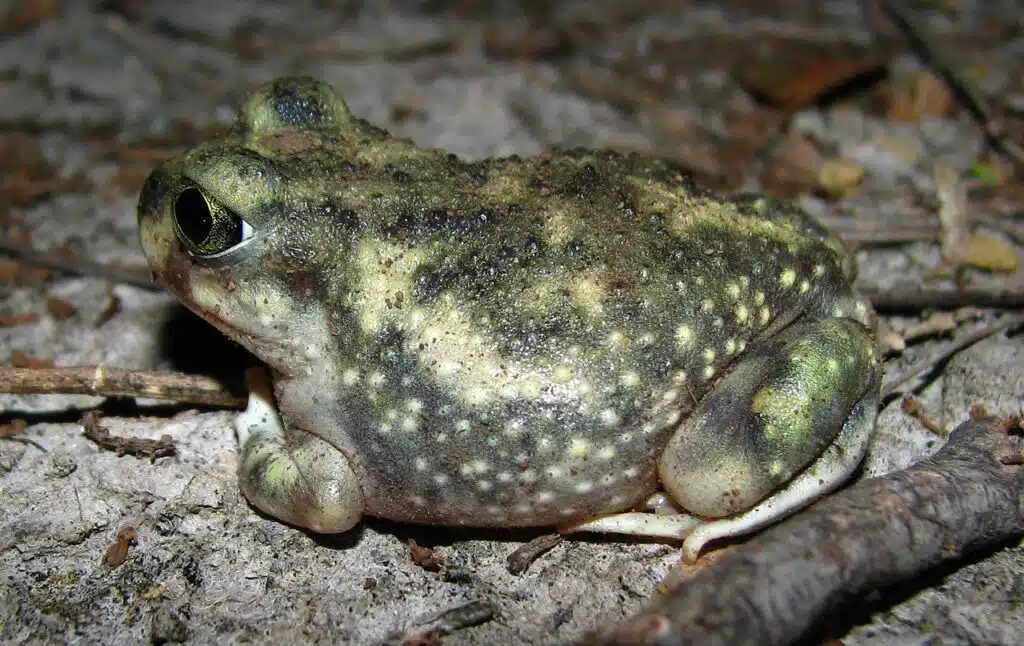
This species of toad (Scaphiopus couchii) is found around The Sonoran Desert. Native to California and Arizona, the species has green and brown coloring.
A base green color with brown dorsal patterns is specific to this species.
Vertical pupils help differentiate Couch’s Spadefoot from other similar toads.
A medium to large species, the toad can grow to 3.5 inches in California.
The call of the species isn’t loud or high-pitched as with many other toads. It has a low volume and it resembles nasal groan noises.